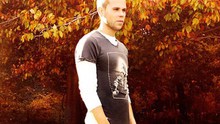Telling the story of what Au Revoir Simone have been doing for the last four years requires you to tell three. There’s the tale of Annie, who became first a mother, then a rock musician; there’s the tale of Erika, who started making music solo, recording novelty pop covers with her friends in her spare time; and there’s the tale of Heather the scientist, who went back to university to study soil in the Tropics.
As a rule, a band deciding to go their separate ways for a while after their biggest commercial and critical success isn’t a particularly sensible career move. But it’s fair to say Au Revoir Simone had earned a break as much as they’d earned their popularity, after promoting 2009’s gorgeously gripping Still Night, Still Light until they were “brain-fried”.
“We had just finished Still Night, Still Light and we all had a momentum,” explains Heather D’Angelo, describing her own decision to re-enlist at on an environmental biology course the University of Columbia as “extremely random and probably the worst timing ever”. “But at the same time we all wanted to do different things so it was good timing for us. Not necessarily the most amazing timing, I think, if we had been with a record label – they would have been like, ‘Are you insane?’”
It’s now been more than four years since the last Au Revoir Simone album, which is longer than it took the band to release their first three. Their 2005 debut, Verses Of Comfort, Assurance & Salvation, and its 2007 follow-up, The Bird Of Music, were the sound of D’Angelo, Annie Hart and Erika Forster writing the ingredients list for their music – three keyboards played with agonisingly downbeat beauty, vocals delivered with a soft, sombre sobriety, and yet a strange sense of uplift derived from the trio’s innate pop sensibilities.
They perfected the recipe on Still Night, Still Light. From the pulsing, gloomy defiance of ‘Shadows’, to the pleading expanse of ‘Only You Can Make You Happy’ to the scatterbrain simplicity of ‘Anywhere You Looked’, it was an album that set the bar for every so-called “dream-pop” group around, and countless others across the indie/pop spectrum. By the time they finished touring it, Au Revoir Simone were critically acclaimed, with a fanbase growing by the day, and they were David Lynch’s favourite band.
What the fuck are you meant to do after that?
“I think we all knew that we didn’t know,” says Forster. “We didn’t break up but we got rid of our rehearsal space – we didn’t want to keep paying every month for it if we weren’t using it – and we just took a break.”
AH: “We were still an active band but we weren’t rehearsing. Heather was still in school, I had a kid, Erika was doing everything. It was too busy to make a plan.”
Odd projects came in here and there: Au Revoir Simone recorded ‘How Long’ with Johnny Marr as part of the Ray-Ban Raw Sounds project, they collaborated with Air on their soundtrack to the 1902 Georges Méliès film La Voyage Dans La Lune, and they worked on a short film commissioned by posh clothing brand Miu Miu and directed Giada Colagrande.
What reporters seemed to miss at the time of the latter, was that as well as writing the rather Lynchian music for The Woman Dress, Hart, Forster and D’Angelo also starred in the seven-minute movie as three witchy alchemists who put actress Maya Sansa in a bath and cast a spell that turns her into a dress. As you do.
“It was really fun!” says Hart. “The only downside was we were in this big draughty loft on a day in October when there’d been a blizzard, so it was freezing cold. We had to look like really confident, sexy witches, but the whole time were like brrrrrrrrrr!”
Despite these occasional reappearances, to the outside world, the matter of whether or not Au Revoir Simone would make a new album remained a mystery. Was there ever a point when the band themselves thought it might never happen?
EF: “Yeah, we didn’t not think that, but we didn’t think that either. We were all a little brain-fried from being on tour and I think that I had that experience of coming back to Brooklyn and feeling like we hadn’t lived here for many years because we’d been travelling so much. I think there was more of an excitement around being like, ‘Okay, what’s going on now? What are the bands now? What are our friends doing now?’ Just reconnecting with some reality that we had become a little estranged from.”
There’s also the issue that all bands face when they’ve found a formula that works – how do you go about building on it without repeating yourself? It’s a question that troubled D’Angelo: “I think my hesitation about making another album at first was that I felt like we already had three keyboard albums. I was like, ‘How are we going to possibly stick with these limitations we’ve put on ourselves and make another album?’ It felt like it was just going to be more of the same.”
Fortunately, the future of Au Revoir Simone was becoming clearer by the time D’Angelo graduated. “By that time we had some new songs,” Forster explains. “We had a lot of new songs, we had a lot of new keyboards and we were all of us chomping at the bit to get started again. That was two years ago. Then it takes us a while to make the album [laughs]. It’s like we use the scientific method or something.”
AH: “I think of it like a tree diagram: if this, then this; if this, then this; what happens if this part of the song comes here?”
EF: “It’s like we have to go down every branch.”
AH: “That’s why I think our break wasn’t actually that long – it was from November 2010 until… June of 2011. It seems like it was a four year break, but it was really only a short break with a lot of prep work.”
Still, it seems fitting that Au Revoir Simone's new album, Move In Spectrums, should open with the lyrics, ”It’s a long time coming / A long time gone away”. Over its 11 tracks, it’s what all successors to great albums should be: it’s the same but different, building bigger rhythms, bolshier hooks and brighter textures into the same fragility, the same subtlety, the same piercing humanity that made Au Revoir Simone so captivating and special in the first place.
Perhaps the greatest shift has been towards a more percussive sound. “[Heather] said she was quitting the band if we didn’t have a drummer,” jokes Hart.
HD: “And then Erika was like, I am totally a drummer now.”
AH: “There was actually a long period where I was playing the drums and I think that kind of helped us create more interesting rhythms because we do everything collaboratively, so the girls would be like, ‘Can you try something with a do-do-do?’ and it made it easier to change patterns and have more interesting things going on in the context of the song.
“What ended up happening was we would integrate the parts that I was playing onto a recorded drum track because in the end, a three keyboard band is a lot more powerful than a two keyboard band. There’s so much more you can do if the sound is feeling a little empty, so we essentially incorporated those more rhythmic ideas into the songs, but then we went back to what we were doing.”
The same, but different. It was certainly enough to ease D’Angelo’s concerns about building on the band’s previous success: “I think because [Erika and Annie] had both done so many other things, but outside of Au Revoir Simone – Erika had all these amazing drum ideas, Annie had been playing rock music – when we started coming together and writing songs it was like being the same band but also totally different. It was a different filter and different influences.”
The process of making Move In Spectrums then, took Au Revoir Simone back to basics, both in the sense of the band reassessing their approach to songwriting, and literally in terms of the setting they made their music in. The new material was written in a “really dive-y” practice space they had used years earlier, before they’d upgraded to the much nicer one which they left during that period of ambiguity following Still Night, Still Light. “When we went back to look for another space, the best deal was to get back in that old, original space that we had been so happy to get out of,” Forster says.
“It was a nice home for us and we were able to leave all of our instruments set up, which is hard in New York because space is so tight. We just started meeting up – I mean, it was when Heather was graduating so at the beginning, we didn’t have a ton of time. We were doing once a week or whatever. We all had little side jobs and stuff. It was a little bit of a slow start and then it just felt natural to be coming in three days a week. And then daily.”
D’Angelo gave an interview in January last year, saying she expected the album to be out that autumn, but in the end, according to Forster, “It took us a year longer than we thought.
“I think when you have songs that you think are ready to record, you bring them in to actually record and you realise they’re not even finished being written. Or that’s what happens to us. We felt like all these songs were finished but you start to record them but you open up a whole doorway of other possibilities. Refining, refining, refining.”
“And because it is so collaborative and since we’re such perfectionists, every little song ends up being workshopped for a really long time until we’re all happy with it,” says D’Angelo. “There’s definitely some songs on the album that were brought in like, ‘That’s perfect! Done!’ but there were definitely some other songs that were like pulling teeth, trying to all get on the same page.”
The challenge isn’t over yet: Au Revoir Simone now face the task of reasserting themselves in a fast-moving music industry after a perceived four-year gap in which the very existence of the band seemed, at times, vague at best. Hart, however, is pragmatic about the future: “I have no idea how many people are going to listen to the record or how many people know about us. The only thing is that we have this piece of art that we worked so hard on, that we love, and there’s really nothing else we can do about it.”
What have Annie, Erika and Heather been up to?
Annie Hart gave birth to her son, Henry, shortly after Au Revoir Simone began their hiatus, and toured with Pursesnatchers and Uninhabitable Mansions
“I play in a band with my husband called Pursesnatchers. It’s really fun to play somebody else’s music and enjoy the sound. I spend so much of my mental energy on this project [Au Revoir Simone], it’s nice to just relax and play six songs in the key of G and not worry about it. And then I played in this other band with my friend called Uninhabitable Mansions and that was really fun. That was a couple of guys from Clap Your Hands Say Yeah. We were basically all really good friends and just wanted to hang out.
“I come from the hardcore and punk scene and I think that I really like spazzing out! One of the things I really learned is that Heather, Erika and I have such a magical connection in as far as our composing and our energy and the way we write together and work together goes. It’s very different to any other project I’ve ever been in, and it took being in other projects to realise how magical and special that connection is. It’s really unique and I’ve always loved it.”
Erika Forster released a self-titled solo EP under the name Erika Spring and played alongside members of Chairlift, Class Actress and TEEN in an all-female covers group, Girl Crisis
“The solo stuff, initially, I didn’t have a label. I was just making it for myself so I could be as weird as I wanted to. It ended up being synths and pretty, dreamy music anyway but some of my demos were super-strange and I really enjoyed that process of being a little more wild and free, making really weird stuff, and then turning it into an EP.
“I started coveting a different style of synth. I think in Au Revoir Simone I’ve always been drawn to these huge, sweepy ‘80s synths and ‘80s drum machines and I think on my solo stuff I started to like these very reduced sounds that were more cheesy ‘80s, and then have the drums be more pro, more huge. And just being able to work on the drum beats, because I had never really been interested in that before – I’m so melody-obsessed – meant that was a really good experience.”
Heather D’Angelo went to the University of Columbia in New York to finish her degree in Environmental Biology
“I’m a soil microbial ecologist. I look at communities of microbes in the soil in the Tropics. I did my work Borneo. In my lab it’s all 18-, 19-year old girls, and several of them were really big Au Revoir Simone fans so that was super-weird, but really cool. In the lab I’m just a scientist. I think I’ll be juggling my science and music career my whole life, I hope. It’s weird but it’s what makes me happy.
“I feel like I’ve been living under a rock in the rainforest for the past couple years. I haven’t really been following bands or going to shows, or really even listening to music, or paying attention to anything with how the music industry has changed. I mean, Instagram wasn’t invented the last time we put out an album, that’s different!
“One thing that was really interesting, being in a lab with all young teenagers, was other people’s experience of music. That was where I learned that the younger generation, they don’t listen to whole albums anymore, they only listen to singles, and they were all using [US internet radio station] Pandora and mashing together whatever. That’s just such a different way to experience music to the way I do in my life. I listen to whole albums all the time, I think we all do.”
Move In Spectrums is released on Moshi Moshi on September 23rd.
Main photo by Sebastian King.























